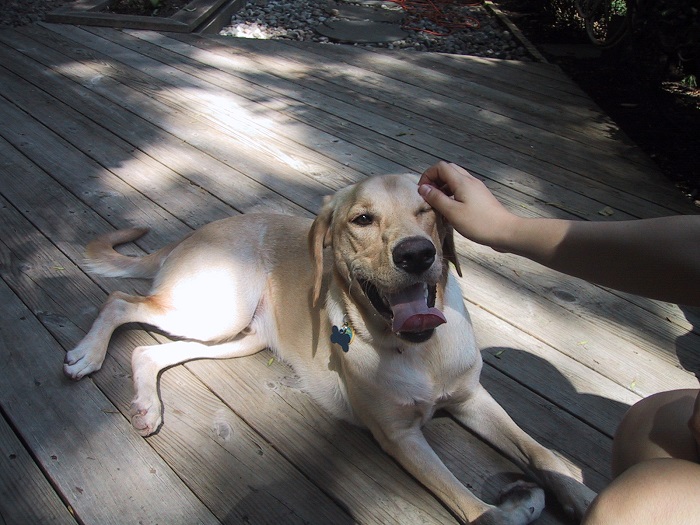This monthly column is a space for simple, useful directions, tips and information to help you keep your animals safe and happy. Today’s article is the second in a series of three exploring dog massage.
In the first article in our dog massage series, I outlined the basic canine strokes and discussed the general benefits to your dog. I also reviewed instances when it is ill advisable to perform dog massage. Remember, walk your dog before performing massage. Doing so helps your canine friend release any excess energy and is fully relaxed.
The Chest
Have your dog in a seated position so that you are behind them. Reach around and using the flat of your hand (tips of fingers for small dogs) begin a percussive stroke horizontally across the chest; four or five times at a light intensity, four or five at a medium intensity, and a final four or five strokes at a high intensity. Use your judgement when performing this, or any massage to gauge the relative levels of intensity suitable for your dog. After all, this is for relaxation, not punishment!
Find where the bicep meets the pectoral muscle at the top of the front leg: using the cat’s paw stroke, knead the area, once or twice lightly, then moderately and lastly heavily. On the heaviest pass, feel for any spasms or knots; if you find any, use direct pressure (10 light seconds, 15 moderate seconds, then 20 heavy seconds). Repeat for the other leg.
End with a series of heavy percussive pats across the chest.
Back
[related_content slugs=”pet-patter-dog-massage-part-one-therein-lies-the-rub,pet-patter-saving-your-pets-life-part-three-choking,pet-patter-animal-grab-bag,pet-patter-for-the-love-of-leash” description=”More Pet Patter” position=”right”]Sit beside your dog, or if she is on a table, stand beside her. Put one arm loosely around her neck, to keep her still and stabilized. Run your thumb down both sides of her spine with a light-to-moderate pressure. (Never put pressure directly on the spine.) Repeat several times.
Now, focussing on one side of her spine, using the percussive stroke (loose and limber fist) move from the top of her shoulder to the area approximately one hand’s width from the hip. Go no further, as the dog’s kidneys are located there and should never be massaged. Repeat this stroke two or three times.
Next, starting at base of her tail, with an open palm and moderate to heavy touch run your hand all the way up against the one side of her spine (beside, not on it) and back again. Remain mindful of the pressure you are applying to your dog. Repeat four times.
Now, using the tips of your fingers, trace large light circles along the one side. Repeat, tracing smaller circles while applying a moderate pressure. Finally, trace small circles with a heavy pressure.
Begin to feel along the area for any knots. (It is typical to find two-to-four on a dog’s back). Once you find one, apply direct pressure (10 light seconds, 15 moderate seconds, then 20 heavy seconds). Finish off with moderate percussive strokes.
Again, remember to stay well away from the sensitive kidney area.
Once you have completed this program for one side of the dog’s back, you can repeat the sequence along the other.
Hips
Bring your dog to a standing position. Standing alongside your dog, feel for the bony protrusion at the top or point of the hip and apply your palm to the area for 20 seconds. You dog may be inclined to sit, given the kind of pressure being applied; this is fine.
Using the palms of both of your hands, use the compression stroke in an arc or C-shape along the hipbone (light, moderate, and then heavy).
Within that C-shape, apply small circles in the usual ascending strength. Once you reach heavy circles, feel for knots and treat using direct pressure (10, 15, 20 seconds).
Now turn your attention to the back of the hip. This area is often tight and in need of massage, especially if you have a particularly active dog. Using the percussive stroke move along back of hip for pretty much as long as you have the strength or as long as the dog likes it.
Using the top of the hip as an anchor for your thumb, knead the back of the hip (lightly, moderately, and then heavily); apply direct pressure (10 seconds, 15, then 20) each time you come across a knot or spasm. Finish with moderate percussive stroke.
Rump and Thigh
Ideally, your dog should be standing for this procedure. Begin with a moderate to heavy percussive stroke around the rump and down the thigh to warm up the muscle area.
Knead the rump and down the top of thigh, moving along every inch or so, using heavy pressure. Feel for and treat any knots you may find. If your dog lets you know of a tender area, administer a lighter touch so you can help to release the knot without causing your dog any discomfort or pain. Finish with heavy percussive strokes.
A few final thoughts
Dog massage should not replace veterinary care, but rather should be seen as an accompaniment to it. If your dog is in serious pain or is exhibiting unusual physical symptoms, seek proper veterinary advice.
The act of pet massage ought to be relaxing for both your pet and for you, so make sure you are in the right frame of mind before you begin. Do not hesitate to pat your dog or praise him while administering massage. Be sure to speak softly. Your dog should view this process as a treat or reward; something to enjoy, not endure. Let us do everything we can to make them feel safe, stimulated and loved.
—
Samantha Bennett lives and writes in Montreal and is the owner of the pet care business Mille Pattes. She can be reached at info@soinsmillepattes.com.
